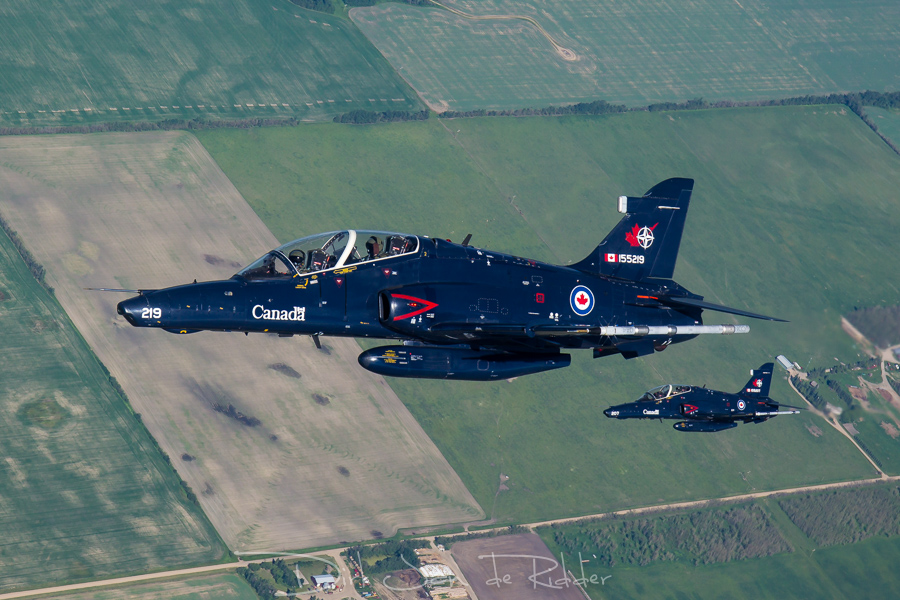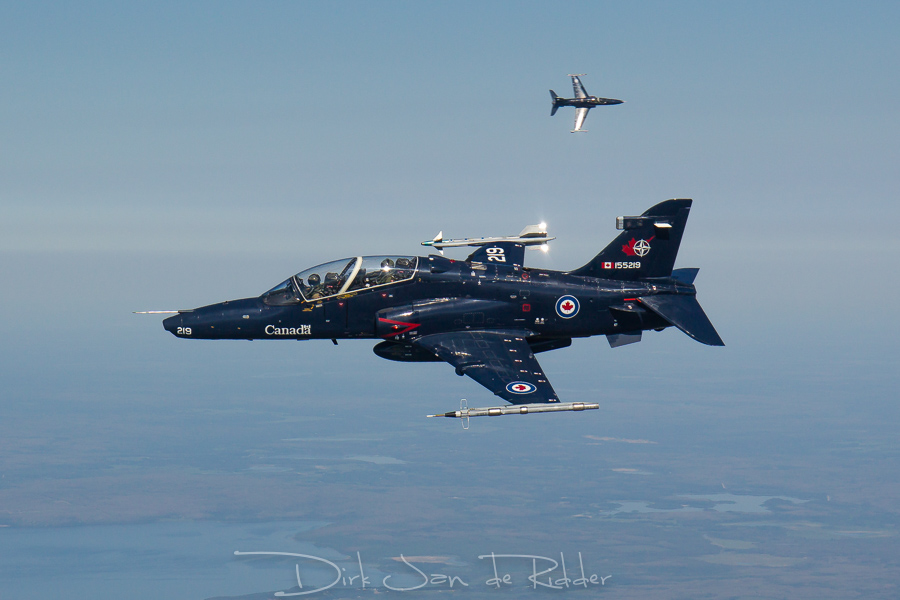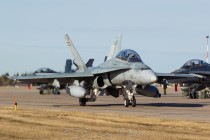The Last Step – NFTC Phase IV pilot training

The sun rises over Cold Lake as a bunch of young Canadian, Hungarian and Singaporean pilots walk out to their CT-155 Hawk jets. With several years of pilot training behind them and already cleared solo on the Hawk, this is a new chapter in their careers. Here at Cold Lake they will be taught to wear the aircraft like a suit, maneuver it to the limit in combat and kill bandits while staying alive themselves. After years of making part of a relatively ‘safe’ training environment, this marks the first time they are part of a squadron. The pressure is on to demonstrate they are not just pilots, but fighter pilots.
Royal Canadian Air Force lieutenant Caleb Robert is one of those students in Phase IV of NATO Flying Training in Canada, the final phase before hopefully converting to the Hornet. He says: “Once you come here it is a one-minded focus. This is the fighter community. I was definitely a bit intimidated by that and I think a lot of students are a little unsure if this is really going to be for them when they get here. I really do think it’s one way or the other. Either you think this is too much and not exactly what you thought it was going to be, or you think this is awesome. I was definitely in that [second] camp! After my first flight here, I was convinced. That one hour of the first fighter flight was better than the 200 [previous] hours of flying.”

Lieutenant colonel Colin ‘Moose’ Marks, commanding officer (CO) of 419 Tactical Fighter Training Squadron, is the squadron’s first CO to have originally been trained on the Hawk as part of NFTC’s Fighter Lead-In Training (FLIT) program. He explains what students get to do during their short time with the squadron: “The syllabus is a building-block approach. There is two to three weeks of ground school training and then they go right into dogfighting. We start with the basics, 1-v-1 basic fighter maneuvers and then into 2-v-1. After that we move into the ACT [Advanced Combat Tactics] phase and once that’s complete the air-to-ground phase where they’ll do an academic bombing pattern. Then after that we put it all together and they will do a self-escort strike phase. They take themselves out to the combat training area, push out on time, fight their way in, drop bombs and fight their way out, followed by a thorough debrief where the instructors reconstruct the mission and highlight all of the critical lessons learned.”
With some 2300 hours on the Hornet, both at Bagotville and Cold Lake as well as with the US Navy on the legacy and Super Hornet, the CO knows exactly what his students need. And that has changed a lot since he was a student, he confirms: “The syllabus has gotten better over the last 15 years. When I went through as a FLIT student we never used to do close air support at all. Now we have a robust close air support phase to help us better support our ground forces engaged in the land battle below. We did do self-escort strike, but at that time we didn’t do time sensitive targeting or dynamic targeting. These are all things that you’re doing every day in the modern battle space, so the training has changed to reflect what is being done real world. That is very exciting. A lot of the comms and the tactics have changed to reflect what is really going on. It is a building block approach, yes, but we are as close to the front line as you can possibly be, but still giving them the developmental learning, entry-level examples, and increasing the intensity from there.”
“Everything we do here should be as close to the front line as we can possibly make it. We focus on developing the ‘Warrior’s Spirit’, and like to think of the Hawk as more of an F/A-155 fighter than a CT-155 trainer. We are trying to make a course that will best prepare them for the operational training units. Whether that is here in Cold Lake at 410 Squadron, in Hungary or in Singapore, we want to make sure that the students are well prepared. The failure rate has traditionally been between 10 and 20 percent. If it is too easy and the students pass through here, but then fail at the next level where it is more expensive to train, then we are not doing our job. It has to be efficient, effective and representative training of what they are going to get at the next phase. When they go over to the F-18 school, they know how to walk, talk, fly fighters and they are just transitioning to a more sophisticated aircraft. Ideally, all they should really need to do is take the Hawk patch off and put a Hornet patch on. The foundation is already there.”

Lieutenant Robert has just completed the basic fighter maneuvers phase. He describes the progress he has made so far: “The foundational 1-v-1 dog fighting principles are kind of the hardest to get. Once you have that, then you build upon it. You will start the set with one aircraft behind the other. If I start defensive, my job is to neutralise, get offensive or get out; but if I am offensive, I’m trying to kill that bandit – not get neutral and definitely not get defensive. The last four flights [during the BFM phase], you start neutral and meet each other in the middle. You are flying against the other student’s instructor, because he is the one that can present you with the high aspect sight pictures he knows you need to see. And then you’ll switch. Against an instructor you definitely have that fighter spirit, but in the back of your head is that voice saying he has a lot more experience than me, he is probably going to beat me. Once we get into the phase that I just finished, they introduce a student versus student. That’s the first time you do that, so once the other student is flying, that is your chance to really prove yourself. You are friends, but as soon as the fight is on he is my worst enemy and I am doing everything I can to defeat him. That is a lot of fun!”
Canadian, Hungarian and Singaporean students are currently being trained at Cold Lake. Instructors come from those same countries, plus Germany and the United Kingdom. Foreign instructors typically sign up for three years, but many of them extend their stay by one or two years. With an annual total of some 3,000 flying hours, 419 squadron’s Hawks have one the highest flying rates of any Hawk operator in the world. The course takes an average of six months consisting of 37 sorties and 45 flight hours per student, but it may last as long as eight months if winter weather makes it difficult to fly. Lieutenant Colonel Marks: “The winter is very cold here, it’s why they call it ‘Cold Lake’! It is so cold that we have to wear full winter exposure flying gear. It makes the cockpit very small when you have all those layers on. Sometimes we hit the limit where it is too cold to fly, where if you were forced to eject you would freeze to death in parachute before you hit the ground. The amount of cloud cover, the cold temperatures and icing within the clouds can make it challenging for us to run our daily operations.”

To mitigate these challenges, the squadron has deployed to Naval Air Facility El Centro, California in winter during the last two years. Lieutenant Colonel Marks: “Winter can slow down our training significantly, so the best thing we can do is chase the good weather. El Centro is an amazing place to train. I came to love it during my US Navy exchange tour with VFA-125 and VFA-122. We have built a great relationship with CAPT Alfonzo [NAF El Centro’s base commander] and the facility staff. The weather is always fantastic, the airspace is literally right there, and everyone is so accommodating. You take off and you are basically in the airspace, which cuts down on transit time and fuel costs, and allows for more tactical training. We can conduct every mission that we need there.” The squadron usually takes three or four courses down with them. Some students will be at the beginning, others will be at the middle or the end of the course, so all aspects of Phase IV training will typically be carried out during these few weeks. A Hawk simulator obviously isn’t available at El Centro, so simulator flights for each student’s specific phase will be ‘front loaded’. Students carry them all out, sometimes with one or two trips at the Cold Lake local area ranges, before heading south. The air space around El Centro has more traffic, making the deployment a great opportunity to train in an unfamiliar environment.
Nothing beats the training opportunities at Cold Lake though, due to its enormous amount of largely unrestricted airspace, shooting ranges and targets. It is not for nothing that one of the world’s premier fighter exercises, Maple Flag, takes place here every year. Lieutenant colonel Marks: “We are very lucky in Cold Lake to have this amazing air space that we have. The training range itself is immense. I think it’s the best in the world in terms of air-to-air and air-to-ground training. At FLIT, we don’t drop any live weapons off the aircraft. It is all simulated, but from an operator’s perspective it is seamless, using the targets on the CLAW [Cold Lake Air Weapons] range. We are spoilt with hundreds of targets that are real vehicles, real tanks, real surface-to-air missile sites, barracks, bridges and an urban training complex that allows us to train to modern day scenarios where eliminating collateral damage is our primary concern.”

The training command is keeping a close eye on Canada’s future fighter project. Despite remaining an industrial partner in the F-35 program, Canada cancelled its 65-aircraft order in November 2015 following a change in government. A new competition now includes the F-35, Gripen, Rafale, Super Hornet and Typhoon. Lt Col Marks believes that a new jet is probably needed to train future pilots in the best possible way. “The two projects are linked together. Wherever the government wants to go with the future fighter, the training command will take that as the lead and we will change our training to best suit whatever aircraft they buy. Whether that is that we will buy our own future fighter lead-in trainer to replace the Hawk or whether we participate in an allied pilot training center, there are a lot of options.” Last year, the Royal Canadian Air Force extended the NFTC contract with CAE until at least 2023, with an option to extend it for an additional year. This will reportedly allow the government the time necessary to determine its future pilot training requirements.

After successfully completing the FLIT course with 419 Squadron, students will have completed their training at NFTC and they are ready to truly make their dream come true. Canadian students remain at Cold Lake to fly the CF-188 Hornet with 410 Tactical Fighter (Operational Training) Squadron. Hungarian pilots complete their Gripen conversion training in Sweden, while Singaporean students move to the United States for converting to the F-15 or F-16. Lieutenant Robert meanwhile still has some way to go. He concludes: “It is tough, but at this point in the game there is a lot of reward from the work that you are putting into it. I’m not saying previous training wasn’t rewarding, but we were just taking off, landing, doing some basic aerobatics and stalls, which is all a lot of fun, but then you get back on the ground and do the same thing the next day. Now every single flight is different. You’re fighting against a friend and even if you lose you still feel pretty good about it, because you’re dogfighting. How cool is that?”
A full report appeared in several magazines, including in AirForces Monthly:






Comments are closed.